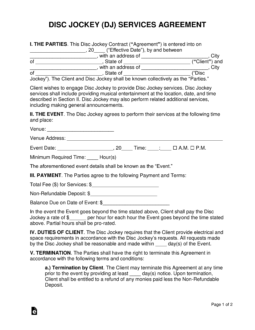Updated September 14, 2023
A disc jockey (DJ) services contract outlines an agreement between a DJ that provides music and entertainment to a client for payment. A DJ is usually paid per-gig or per-hour ($/hr), with a deposit to be paid upfront when signing the contract.
Depending on the DJ, the music that is played may be original (by the artist) or songs that are requested by the client or an event’s attendees.
Common Events & Venues
- Anniversaries
- Birthdays
- Clubs
- Corporate Events
- Radio
- Restaurants
- Reunions
- Weddings
Table of Contents |
What is a DJ Contract?
A disc jockey (DJ) contract is used to hire entertainment to play music and entertain guests. The term “disc jockey” or “DJ” is a wide-ranging term used to describe a person who plays popular songs or an artist who creates unique original music.
The amount paid to the disc jockey is entirely dependent on the popularity of the individual as well as the event. This agreement may be used for events such as a wedding, bar, nightclub, or related occasion.
Video
DJ Average Pay ($)
This ultimately depends on the event, the equipment required, and the number (#) of hours. According to Thumbtack, a DJ is paid $570 to $750 per gig.
What’s Included in a DJ Contract?
The following items should be included in a DJ contract:
- DJ’s Name – If a specific person is requested;
- Event Date & Time – Start and end times;
- Rate ($) – Either on an Hourly ($/hr) or per event basis;
- Termination – Terms under a cancelation by either party; and
- Duties of Each Party – List whether the client or the disc jockey is responsible for providing the speakers, electricity, and any other requirements for the music to be played.
Sample
Download: PDF, MS Word, OpenDocument
DJ SERVICES CONTRACT
1. THE PARTIES. This agreement (“Agreement”) is entered into as of [Date], by and between:
DJ: [DJ’s Name] with a mailing address of [MAILING ADDRESS] hereinafter referred to as the “DJ”, and:
Client: [Client’s Name] with a mailing address of [MAILING ADDRESS] hereinafter referred to as the “Client”, collectively referred to as the “Parties”.
2. EVENT DETAILS.
- Date of Event: [DATE]
- Location of Event: [LOCATION]
- Start Time: [START TIME]
- End Time: [END TIME]
- Type of Event: [EVENT TYPE]
3. SERVICES.
The DJ agrees to provide music and entertainment services for the Client’s event as outlined above. This may include, but is not limited to, playing music, making announcements, and providing lighting/effects.
a.) Additional Requests: (check one)
☐ – No additional requests.
☐ – Additional requests are the following: [ADDITIONAL REQUESTS]
4. PAYMENT.
- Total Amount: $[AMOUNT]
- Deposit: $[AMOUNT] which is ☐ non-refundable ☐ refundable.
- Payment Method: [PAYMENT METHOD]
- Cancellation: [DESCRIBE TERMS]
5. EQUIPMENT. The DJ will provide all necessary equipment to perform the services, including speakers, microphones, and music players. The venue must provide an adequate power supply.
6. INDEMNIFICATION. The Client agrees to indemnify, defend, and hold harmless the DJ, its agents, and employees, from any claims, damages, or legal expenses arising out of the event, except those resulting from the gross negligence or willful misconduct of the DJ.
7. FORCE MAJEURE. Neither party shall be held liable for any delay or failure to perform due to causes beyond their reasonable control, including but not limited to acts of God, war, strikes, or natural disasters.
8. MISCELLANEOUS.
a.) Photo/Video Consent. The DJ may take photographs or videos of the event for promotional purposes unless the Client requests otherwise in writing.
b.) Requests. The DJ will make reasonable efforts to play music requests but makes no guarantees to have specific songs available.
9. GOVERNING LAW. This Agreement shall be governed by and construed under the laws of the State where the venue is located.
10. ADDITIONAL TERMS. [ADDITIONAL TERMS & CONDITIONS]
11. AMENDMENTS. This Agreement may only be amended in writing and signed by both Parties.
12. ENTIRE AGREEMENT. This Agreement contains the entire agreement of the Parties and supersedes all prior negotiations, understandings, and agreements between the Parties.
DJ Signature: ____________________ Date: ________
Client Signature: ____________________ Date: ________


